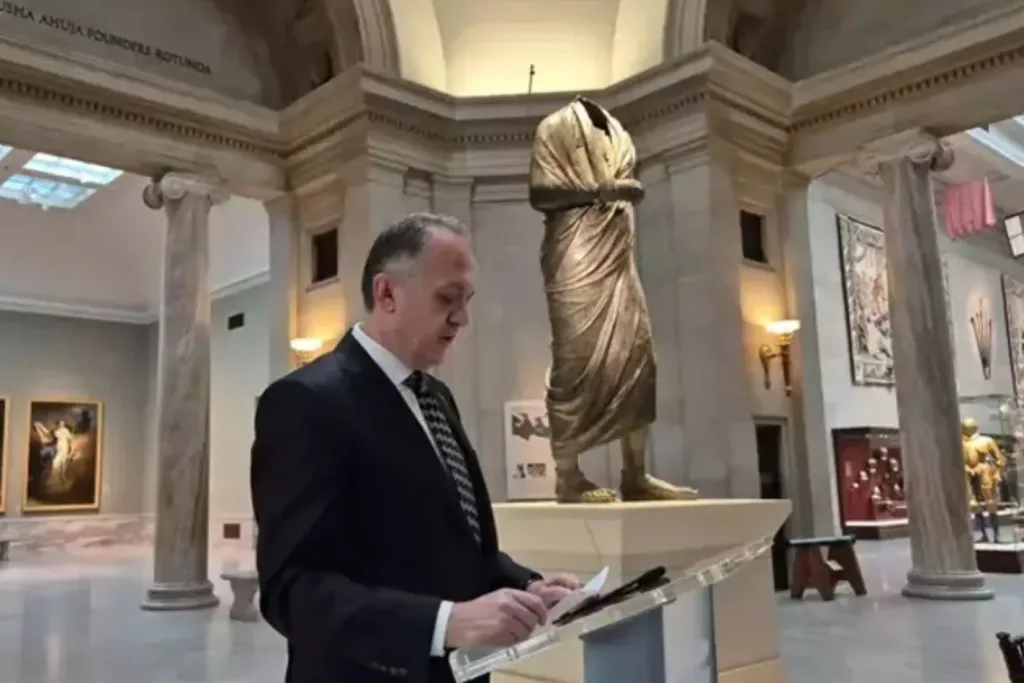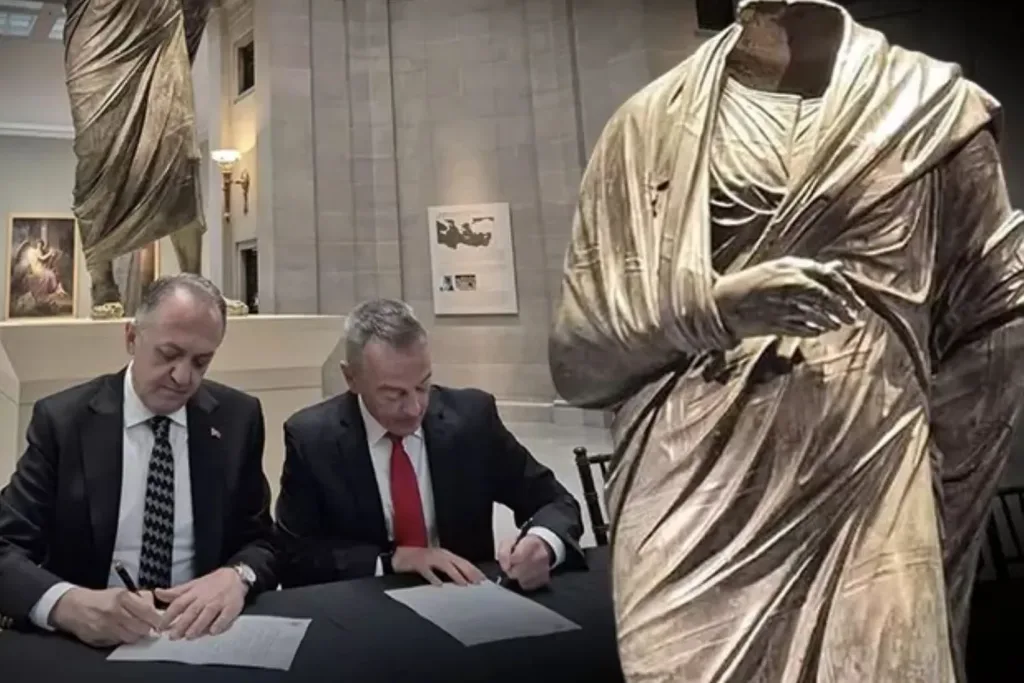The bronze statue of Roman Emperor Marcus Aurelius, smuggled from the ancient city of Boubon, has been returned to Turkey after 65 years.
Minister of Culture and Tourism Mehmet Nuri Ersoy described this significant return as a “historic success” in a statement shared on his social media account. In his post, Ersoy said:
“It was a long struggle. We were right, determined, patient – and we won… We painstakingly gathered the necessary evidence! And we brought back the ‘Philosopher Emperor’ Marcus Aurelius to the land where he belongs. The Marcus Aurelius Statue, smuggled from the ancient city of Boubon in the 1960s, has returned to Turkey after 65 years. This unique piece, which had been displayed in the USA, was repatriated to our country through scientific analyses, archival documents, and witness testimonies. The process we carried out together with the Manhattan District Attorney’s Office and the U.S. Homeland Security Investigations Unit was not just a repatriation but a historic success, achieved through the combined power of diplomacy, law, and science. Marcus Aurelius’ return to our country is the concrete outcome of our long-standing struggle for justice. Whether domestically or abroad, we will continue to protect all our cultural heritage tirelessly. Very soon, we will present the Philosopher Emperor to the people of Ankara in a surprise exhibition.
I extend my gratitude to our Burdur Museum, our Boubon excavation team, and especially to the Directorate of Combatting Smuggling under the General Directorate of Cultural Heritage and Museums, who all contributed to this process initiated under the leadership of the late Prof. Dr. Jale İnan, a prominent name in Turkish archaeology. I also express my thanks to our national carrier Turkish Airlines for their valuable support in transporting the Marcus Aurelius statue back to our country.”

Smuggled in the 1960s, Ended up in Ohio
Dating to the 2nd and 3rd centuries AD, the statue of Marcus Aurelius was removed from Turkey following illegal excavations at the ancient city of Boubon in the Gölhisar district of Burdur in the 1960s. One of Anatolia’s rarest bronze sculptures, the statue changed hands over the years and eventually entered the collection of the Cleveland Museum of Art in Ohio, USA.
This artifact, which Turkey had been pursuing for over 65 years, was first brought to the attention of the academic world thanks to studies initiated by Prof. Dr. Jale İnan. The statue holds a special place in ancient art history for portraying Roman Emperor Marcus Aurelius as a philosopher.
Joint Investigation Launced in 2021 Yields Results
In 2021, Turkey’s Ministry of Culture and Tourism, the Manhattan District Attorney’s Office, and the U.S. Homeland Security Investigations Unit launched a joint effort. This process led not only to the repatriation of the Marcus Aurelius statue but also of other statues and heads of Roman emperors such as Lucius Verus, Septimius Severus, and Caracalla, also originating from Boubon.
It was definitively proven through years of accumulated scientific data, academic research, archival documents, and witness testimonies that the Marcus Aurelius statue belonged to the Sebasteion structure at Boubon.
The Manhattan District Attorney’s Office and Homeland Security Investigations found Turkey’s repatriation claim justified based on eyewitness accounts of the 1967 illegal excavation, the exact match between the negative impressions on the base and the statue’s foot measurements, and the discovery of a similar sandal design during excavations at the ancient city of Kybra. They ordered the statue to be seized from the Cleveland Museum of Art.
A Process from Courtrooms to Laboratories
In October 2023, the Cleveland Museum of Art contested the seizure order issued by the New York Supreme Court, filing a lawsuit challenging the statue’s association with Boubon. However, laboratory analyses conducted at the Curt Engelhorn Archaeometry Center in Germany conclusively showed that the statue had remained buried in Boubon soil for many years.
In May 2024, under the supervision of Ministry experts, a silicone mold of the statue’s foot was taken, which matched perfectly with bases found in the ancient city of Boubon. Approaching the museum’s request for scientific analysis constructively, the Ministry ensured the process moved forward smoothly.
“We Scraped with Our Nails to Collect Evidence”
Zeynep Boz, Head of the Department of Combatting Smuggling, stated that the Cleveland Museum requested a soil analysis to address its scientific doubts regarding the statue’s origin.
According to Boz, a small hole within the base and a lead protrusion under the statue’s foot were examined to establish a connection. A reference soil sample was required to confirm the statue’s origin. The Valerianus statue, seized in a 1967 gendarmerie operation and preserved in the Burdur Museum, was selected as the reference. Soil inside this statue was compared with samples taken from the Marcus Aurelius statue to determine whether both had been preserved in the same environment.
Boz continued:
“At this point, something interesting happened. The soil inside the statue had solidified, and no soil sample could be extracted. Our restorers and conservators worked hard, but nothing came out. And this was our last chance to eliminate all doubts and declare definitively that this statue was of Anatolian origin, specifically from Burdur. At that moment, instinct took over – we literally scraped with our nails to extract the soil sample from inside the statue. And where the international expert had said ‘no more samples can be taken,’ as Ministry staff, perhaps with a little more belief, we managed to obtain those samples. Of course, all under the supervision of the international expert. We carefully completed the sampling process using acid-free papers.”
Laboratory tests proved that both statues contained identical soil compositions and originated from the ancient city of Boubon.
Following this conclusive evidence, the Cleveland Museum of Art officially notified Turkey through the Manhattan District Attorney’s Office that it had dropped the lawsuit and accepted the repatriation decision.

A Battle That Went Down in History
The return of the Marcus Aurelius statue to Turkey is recorded not just as a repatriation of a cultural asset but as a joint success of international law, science, and diplomacy. It also marks one of the most significant milestones in the Ministry of Culture and Tourism’s fight against the smuggling of historical artifacts.
To be Exhibited Soon in Ankara
In his statement, Minister Ersoy announced that the Marcus Aurelius statue will soon be displayed to art lovers in Ankara as part of a special exhibition. Turkey’s Ministry of Culture and Tourism continues its determined efforts to recover all cultural heritage assets smuggled abroad.

